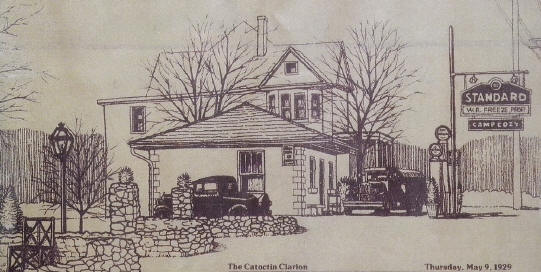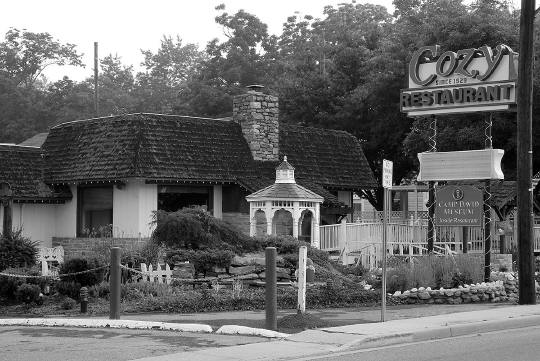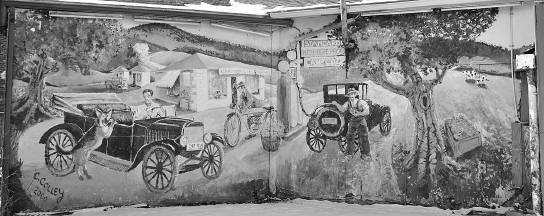Ryan Golden
MSN Class of 2016
In the days leading up to July 4th – the weeks before hot dogs are grilled and fireworks catapulted into the night sky—Americans from coast to coast will no doubt be flocking to major historic sites in celebration of their country’s past. Perhaps they’ll take an annual trip to the birthplace of the Revolution at
Philadelphia’s Independence Hall, or to D.C.’s marble monuments and museums. Locally, it’s probable that a swarm of visitors will overtake the area in and around Gettysburg to pay their respects to the honored dead there.

This is all done, of course, because ‘We the People’ place a fair amount of value in the remnants of our history, either consciously or subconsciously. We treasure centuries-old buildings and celebrate the legends of figures like Lincoln, Douglass, Jefferson, and Franklin. Our federal and state constitutions still
dictate how our governments are run and what laws we must follow, regardless of how much we feel personally toward our history. We have set up federal departments solely for the protection of our national treasures, and displayed those artifacts proudly in a multitude of ways.
But history is not preserved solely in the walls of national landmarks, nor in the stirring autobiographies of presidents and cultural heroes. It is more often kept in the memory of common people, and in common places.
One such place was, until Sunday, June 21st, the Cozy Inn and Restaurant, a mainstay of Thurmont for many decades. The business, which first opened its doors 80 years ago and never moved from the spot of its original foundations, contained unwritten historical volumes within its weathered walls. And while the Cozy
Country Inn continues operation, the closing of the restaurant next door signifies a major blow to an unofficial Thurmont historic landmark—a living piece of history taken away.
The loss of history, regardless of the severity of the damage or the popularity of the subject, is a loss for all. It is untold knowledge cloaked in the guise of simple stories that cannot be rediscovered. Thankfully, the Cozy’s story has not perished from recent events. It is a long and intricate tale that reveals
much about the town, and world, in which it was formed.

Wilbur Freeze, born in 1897, was a traveler and a keen observer of the business world around him. A traveling dietician during the 1920s, Wilbur’s employment forced him to journey coast to coast and allowed him to meet people from all walks of life. He marveled at the nation’s industrial centers at the time,
especially Detroit, where he was inspired by the giant factories of General Motors to make his own mark in the business world.
Freeze combined this admiration with the steady realization of a true historical trend: the growing sales of the newfangled automobile and an increased public desire for travel would, in turn, increase the demand for traveler accommodations and hospitality. He decided to return to his home state of Maryland just
before the beginning of the next decade, aiming to create an establishment that would meet the growing needs of a mobile American culture. That’s why he eventually settled in the burgeoning community of Thurmont, MD. In 1929, Wilbur officially opened "Camp Cozy," which at the time consisted of a simple set-up, including 3 tents, 3 cottages
with showers and restrooms, and a small 10x14 camp kitchen.
Thurmont was, of course, and ideal place for Freeze to set up shop. Nestled in the scenic wilderness of the Catoctin Mountains, miles away from the battlefields of Gettysburg, and also the host of a station of the Western Maryland Railway, the town garnered much attention from travelers. The railway was an especially
significant contributor to the town’s popularity, as it connected the cities of Baltimore, Cumberland, and Pittsburgh and also served tourist destinations such as the Pen Mar Amusement Park, a legendary campground and carnival ride facility near the Mason-Dixon Line.
But for locals, the town was a proud place of industry, where several successful businesses thrived and contributed to building a strong community. They included the Creager Flower Shop, trucking firm Beall’s Express, and, oddly enough, a handful of fish hatcheries that accounted for a whopping 80% of all goldfish
sales in the United States. Jerry Freeze, Wilbur’s son and the present owner of the Cozy, recalls his father talking about the large orchards and farmlands that were weaved beside the curves of the Monocacy River. Whatever the trade, Thurmont’s citizens proved themselves to be able and successful.

In its capacity as a people magnet, Thurmont also attracted its fair share of celebrities. Baseball slugger Babe Ruth, who was originally discovered at Mount St. Mary’s College in Emmitsburg, frequently hunted near Thurmont with teammates, including Lou Gehrig. President Franklin Roosevelt would later make
appearances en route to Shangri-La, the name of the campground that preceded Camp David. Presidential involvement in the area truly began, however, when Lawrence Ritchie, personal secretary to President Herbert Hoover, settled in the area. Ritchie became close friends with Wilbur Freeze, and was known to send gifts to the Cozy, including a
bearskin rug made from the President’s own quarry. The secretary also hosted small parties within his retreat, and invited both prominent townspeople and Washington officials to join him.
Wilbur’s establishment was founded just before the precarious 1930s commenced, bringing worldwide economic panic after the stock market crash and subsequent depression. The Cozy only continued to grow, however, as did the rest of the town, magnificently in spite of the chaos going on in the rest of the country.
This growth was symbolized by the new amenities added to Camp Cozy over the course of the decade. A new block building was erected on the site in 1930, and would contain offices as well as a gas station out front. During the same year, a cottage from Catoctin Furnace Road was purchased by Wilbur and re-designated as
a cottage at the campsite. In 1933, a small 12-stool sandwich counter arrived along with an expanded kitchen, making the site a precursor to the Cozy Restaurant that would later stand there. Wilbur also had a home built for himself on the premises, and relocated another cottage for travelers’ convenience, this time using a former general
store located in Payne’s Hill. The latter part of the decade also brought an outdoor beer garden, the "Little Room," which stood inside the Cozy up until the present day, and outdoor shuffleboards and ping-pong tables for guest use. By 1935, the Cozy Restaurant was officially made open for business, and Wilbur Freeze’s vision had finally
become a reality.
Wilbur employed a growing number of workers in order to help maintain the business, including Mary L. Gehr in 1934, whom he married just a year later. The couple’s son, Gerald (Jerry) Freeze, was born in 1936. Jerry’s memories of the restaurant, and of the surrounding area at the time, are quite vivid. He recalls
very minute details about how the restaurant was operated and of the various projects being added on to it. Jerry remembers how the restaurant stored beer in its early days, making use of iceboxes and getting deliveries from a local vendor named ‘Icy’ Reed. The restaurant received poultry from nearby Hillside Turkey Farm and meat from
Powell’s Meat Market, and also received supplies from Hobb’s Hardware. One of the Cozy’s most popular menu items, a homemade root beer, was also a part of Jerry’s earliest memories. He remembers going out daily with the family housekeeper, Aunt Della, to dig the necessary ingredients for the beverage out of the family garden before going to
back to the kitchen to help with brewing.
With prohibition coming to an end in 1933, the Cozy also began sale of beer and built a bar for this purpose at around the same time. Many brewers conducted business with the restaurant, and some even sent advertising trinkets for the Cozy to display. Heineken, for example, sent a pair of wooden Dutch shoes, while
brands like Duquesne sent signs to be displayed on the walls. Local Blue Laws affected the sale of alcohol, however, and prevented sales from occurring on certain days, despite regulation failing on the national level.
As the 1930s faded into the 40s and 50s, the Cozy began to shift its attention away from travelers and began to target a younger demographic. It continued to host ping-pong and shuffleboard tournaments, but added a dance floor next to the bandstand and more booths for couples. The truck stop was moved to away from
the store front to the back of the restaurant to the back of the property, and the restaurant grew in both seating capacity and kitchen size. The Cozy had competition with several like-minded businesses at the time, including the soda shop Domengue’s, a bowling alley, and a skating rink. Wilbur brought a television into the restaurant in
hopes of attracting more customers, and even added a piranha tank.
In 1961, Wilbur passed away, leaving Mary and Jerry to take over the reigns of the restaurant and inn. Just four years prior, Thurmont witnessed the completion of the new US Route 15. The new road became both a blessing and a curse for the town, allowing drivers to pass by Thurmont on the way to Frederick or
Gettysburg while increasing the volume of people traveling nearby. As a result, the Cozy grew out of its foray with the 1950s, and its walls were literally knocked down in order to make way for new sections.
The new Cozy Restaurant incorporated a family-style buffet, along with separate rooms containing a pub and other seating options. These changes occurred mainly during the early 1970s, and local decorators were hired to help remodel the business. In 1979, the Cozy paid homage to the long since departed Western
Maryland Railroad by purchasing one of the line’s old cabooses for display. The car was restored and placed near the restaurant’s entrance, and later became a useful meeting place for the Thurmont Lions Club, an organization focused on serving the community and preserving Thurmont’s history. Presidential involvement also resumed during the
administrations of Jimmy Carter and Ronald Reagan. The inn and restaurant grew busy with press members whenever peace talks were held at Camp David. Toward the end of its long run, the restaurant remained a popular recommendation for visitors and continued to do its part to protect the history of Thurmont and the areas adjacent to it.
-
The Cozy Restaurant enjoyed a distinguished and influential life in Thurmont, bolstered by the community around it. Its story is one of the most lasting and complete accounts of the town’s past century, and it is because of the memories provided by the Freeze family that it lives on. Indeed, the Cozy’s past serves to
teach us that all stories are valuable when examining history. Perhaps the restaurant’s biography will inspire residents of today’s Thurmont to record their own history, in order to be able pass it down to curious minds years from now—that we might be able to tell our own story.
Read other personal memories of Thurmont's Historical Past
Have
your own memories of Franklinville or
other places in
the Thurmont Area?
If so, please send them to us so we can
included them in our archives.
E-mail us at:
history@mythurmont.net